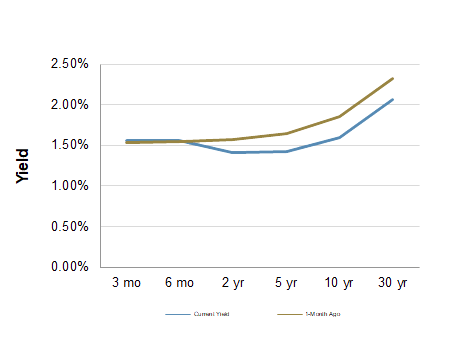Weekly Market Snapshot
Chief Economist Scott Brown discusses the latest market data.
U.S. investors’ concerns about the Wuhan coronavirus fell and rose again as new information came in and market participants tried to gauge the impact on the global economy (still uncertain).
Prior to seasonal adjustment, nonfarm payrolls fell by 2.83 million in January, which translates into a higher-than-expected 225,000 seasonally adjusted gain. Benchmark revisions lowered job growth in 2018, making clearer a longer-term downtrend in job growth. This has little to do with who’s in the White House or running Congress and more to do with the population dynamics (slower growth in the labor force). The unemployment rate edged up to 3.6% (from 3.5%), but that was due to increased labor force participation (note also that the Bureau of Labor Statistics makes population adjustments every January, which adds noise). Average hourly earnings rose 0.2% (+3.1% y/y), less than expected (given state minimum wage increases).
The ISM surveys were stronger than expected in January, with the manufacturing gauge moving above the breakeven level for the first time since July (the non-manufacturing index remained consistent with moderate growth in the overall economy). Factory Orders rose 1.8% in December (-0.4% y/y), reflecting a sharp rebound in defense aircraft (up 168.3%, after falling 69.1% in November). Civilian aircraft orders tumbled 74.7% (-88.8% y/y).
Next week, Fed Chair Powell will present his semiannual monetary policy testimony to Congress. He’s widely expected to signal no change in interest rates for the foreseeable future. However, he should continue to stress that the Fed’s current balance sheet expansion and support for the money markets is not quantitative easing. A number of stock market participants have felt otherwise, helping to propel the major market averages to new highs. Retail sales results should be moderate, but industrial production is expected to remain weak.
Indices
| Last | Last Week | YTD return % | |
|---|---|---|---|
| DJIA | 29379.77 | 28859.44 | 2.95% |
| NASDAQ | 9572.16 | 9298.93 | 6.68% |
| S&P 500 | 3345.78 | 3283.66 | 3.56% |
| MSCI EAFE | 2037.82 | 1999.03 | 0.04% |
| Russell 2000 | 1677.46 | 1648.22 | 0.54% |
Consumer Money Rates
| Last | 1 year ago | |
|---|---|---|
| Prime Rate | 4.75 | 5.50 |
| Fed Funds | 1.75 | 2.40 |
| 30-year mortgage | 3.53 | 4.45 |
Currencies
| Last | 1 year ago | |
|---|---|---|
| Dollars per British Pound | 1.293 | 1.295 |
| Dollars per Euro | 1.098 | 1.134 |
| Japanese Yen per Dollar | 109.99 | 109.82 |
| Canadian Dollars per Dollar | 1.328 | 1.331 |
| Mexican Peso per Dollar | 18.657 | 19.083 |
Commodities
| Last | 1 year ago | |
|---|---|---|
| Crude Oil | 50.95 | 52.64 |
| Gold | 1570.00 | 1314.20 |
Bond Rates
| Last | 1 month ago | |
|---|---|---|
| 2-year treasury | 1.42 | 1.58 |
| 10-year treasury | 1.60 | 1.85 |
| 10-year municipal (TEY) | 1.91 | 2.12 |
Treasury Yield Curve – 02/07/2020

As of close of business 02/06/2019
S&P Sector Performance (YTD) – 02/07/2020

As of close of business 02/06/2020
Economic Calendar
| February 11 | — | Powell Monetary Policy Testimony (House Fin Services) |
| — | New Hampshire Primary | |
| February 12 | — | Powell Monetary Policy Testimony (Senate Banking) |
| February 13 | — | Jobless Claims (week ending February 8) |
| — | Consumer Price Index (January) | |
| — | Fed Nomination Hearing (Shelton, Waller) | |
| February 14 | — | Retail Sales (January) |
| February 14 | — | Industrial Production (January) |
| February 14 | — | UM Consumer Sentiment (mid-February) |
| February 17 | — | Presidents Day Holiday (markets closed) |
All expressions of opinion reflect the judgment of the Research Department of Raymond James & Associates, Inc. and are subject to change. There is no assurance any of the forecasts mentioned will occur or that any trends mentioned will continue in the future. Investing involves risks including the possible loss of capital. Past performance is not a guarantee of future results. International investing is subject to additional risks such as currency fluctuations, different financial accounting standards by country, and possible political and economic risks, which may be greater in emerging markets. While interest on municipal bonds is generally exempt from federal income tax, it may be subject to the federal alternative minimum tax, and state or local taxes. In addition, certain municipal bonds (such as Build America Bonds) are issued without a federal tax exemption, which subjects the related interest income to federal income tax. Municipal bonds may be subject to capital gains taxes if sold or redeemed at a profit. Taxable Equivalent Yield (TEY) assumes a 35% tax rate.
The Dow Jones Industrial Average is an unmanaged index of 30 widely held stocks. The NASDAQ Composite Index is an unmanaged index of all common stocks listed on the NASDAQ National Stock Market. The S&P 500 is an unmanaged index of 500 widely held stocks. The MSCI EAFE (Europe, Australia, Far East) index is an unmanaged index that is generally considered representative of the international stock market. The Russell 2000 index is an unmanaged index of small cap securities which generally involve greater risks. An investment cannot be made directly in these indexes. The performance noted does not include fees or charges, which would reduce an investor’s returns. U.S. government bonds and treasury bills are guaranteed by the US government and, if held to maturity, offer a fixed rate of return and guaranteed principal value. U.S. government bonds are issued and guaranteed as to the timely payment of principal and interest by the federal government. Treasury bills are certificates reflecting short-term (less than one year) obligations of the U.S. government.
Commodities trading is generally considered speculative because of the significant potential for investment loss. Markets for commodities are likely to be volatile and there may be sharp price fluctuations even during periods when prices overall are rising. Specific sector investing can be subject to different and greater risks than more diversified investments. Gross Domestic Product (GDP) is the annual total market value of all final goods and services produced domestically by the U.S. The federal funds rate (“Fed Funds”) is the interest rate at which banks and credit unions lend reserve balances to other depository institutions overnight. The prime rate is the underlying index for most credit cards, home equity loans and lines of credit, auto loans, and personal loans. Material prepared by Raymond James for use by financial advisors. Data source: Bloomberg, as of close of business February 6, 2020.

